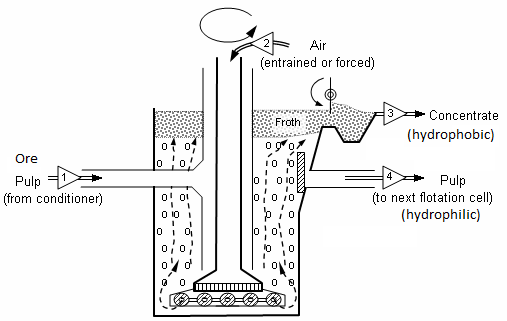
Write the principle behind the froth floatation. What is the role of collectors in this process?
Answer
572.7k+ views
Hint: Try to recall that froth flotation is a method which is used for the concentration of sulphide ores with the help of froth stabilisers and collectors. It is based on the principle of difference in wetting properties of ore and gangue particles with oil and water. Now, by using this you can easily answer the given question.
Complete step by step answer:
- It is known to you that froth floatation is a metallurgical process for selectively separating hydrophobic materials from hydrophilic. It is based on the principle of difference in wetting properties of the ore and gangue particles with water.
- It is used for the extraction of those metals in which the ore particles are preferentially wetted by oil and gangue particles by water.
- This method has been used for removing gangue from sulphide ores. Example: Galena ($PbS$), zinc blende ($ZnS$), etc.
- In this method, a suspension of powdered ore is made with water. To this suspension small quantities of collectors and froth stabilizers are added.
- The role of collectors (e.g. pine oil, eucalyptus, fatty acids, xanthates, etc.) is to enhance non-wettability of the mineral particles and froth stabilisers (e.g. cresols, aniline) help in stabilization of the froth.

Note: Note that froth floatation process is also used for the separation of two sulphide ores by adjusting proportion of oil to water or by using ‘depressants’. Also, you should remember that sodium cyanide is used as a depressant in the separation of zinc sulphide ore ($ZnS$) and lead sulphide ore ($PbS$).
Complete step by step answer:
- It is known to you that froth floatation is a metallurgical process for selectively separating hydrophobic materials from hydrophilic. It is based on the principle of difference in wetting properties of the ore and gangue particles with water.
- It is used for the extraction of those metals in which the ore particles are preferentially wetted by oil and gangue particles by water.
- This method has been used for removing gangue from sulphide ores. Example: Galena ($PbS$), zinc blende ($ZnS$), etc.
- In this method, a suspension of powdered ore is made with water. To this suspension small quantities of collectors and froth stabilizers are added.
- The role of collectors (e.g. pine oil, eucalyptus, fatty acids, xanthates, etc.) is to enhance non-wettability of the mineral particles and froth stabilisers (e.g. cresols, aniline) help in stabilization of the froth.

Note: Note that froth floatation process is also used for the separation of two sulphide ores by adjusting proportion of oil to water or by using ‘depressants’. Also, you should remember that sodium cyanide is used as a depressant in the separation of zinc sulphide ore ($ZnS$) and lead sulphide ore ($PbS$).
Recently Updated Pages
Master Class 11 Chemistry: Engaging Questions & Answers for Success

Why are manures considered better than fertilizers class 11 biology CBSE

Find the coordinates of the midpoint of the line segment class 11 maths CBSE

Distinguish between static friction limiting friction class 11 physics CBSE

The Chairman of the constituent Assembly was A Jawaharlal class 11 social science CBSE

The first National Commission on Labour NCL submitted class 11 social science CBSE

Trending doubts
What is meant by exothermic and endothermic reactions class 11 chemistry CBSE

What are Quantum numbers Explain the quantum number class 11 chemistry CBSE

What is periodicity class 11 chemistry CBSE

Explain zero factorial class 11 maths CBSE

What is a periderm How does periderm formation take class 11 biology CBSE

Mention the basic forces in nature class 11 physics CBSE




